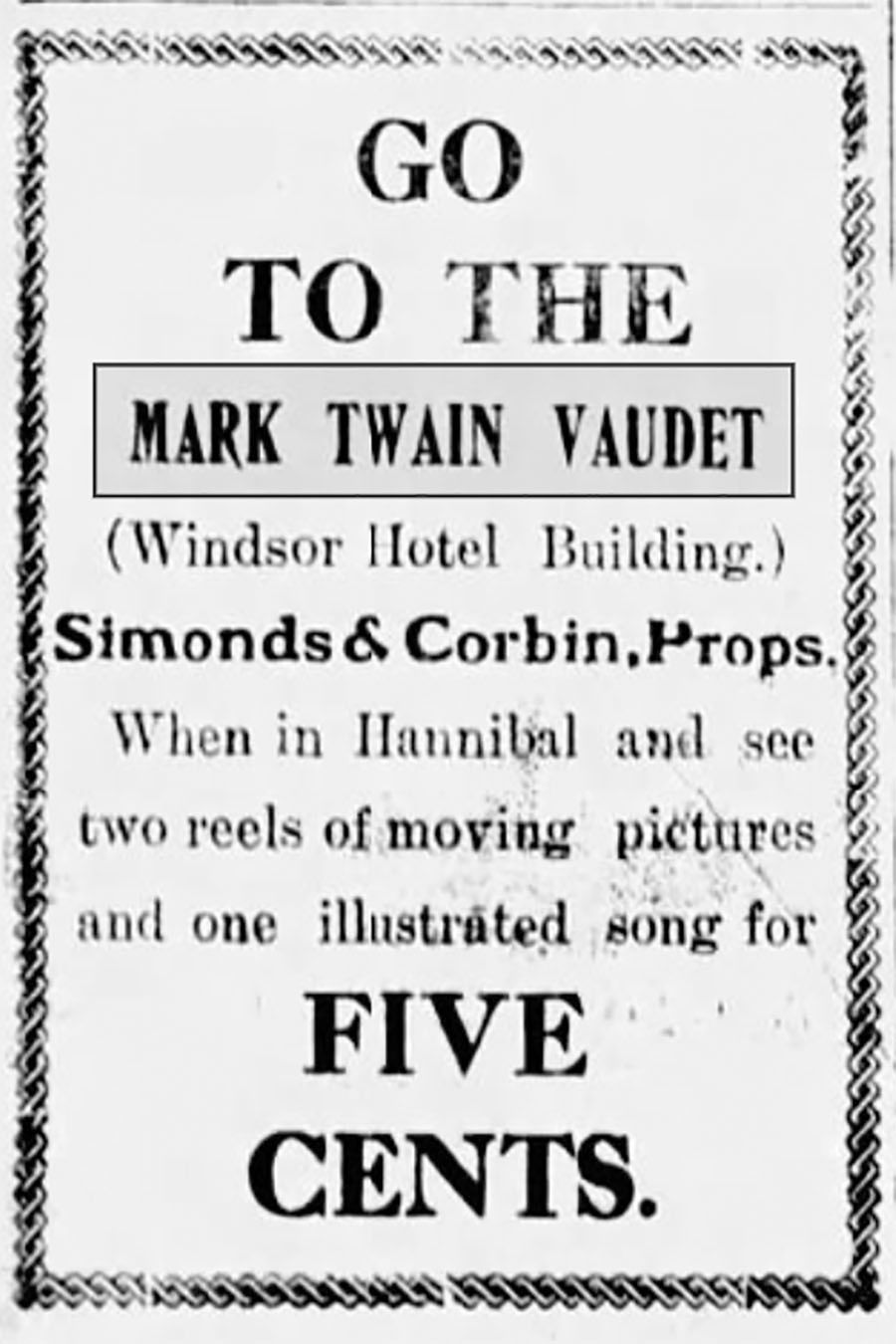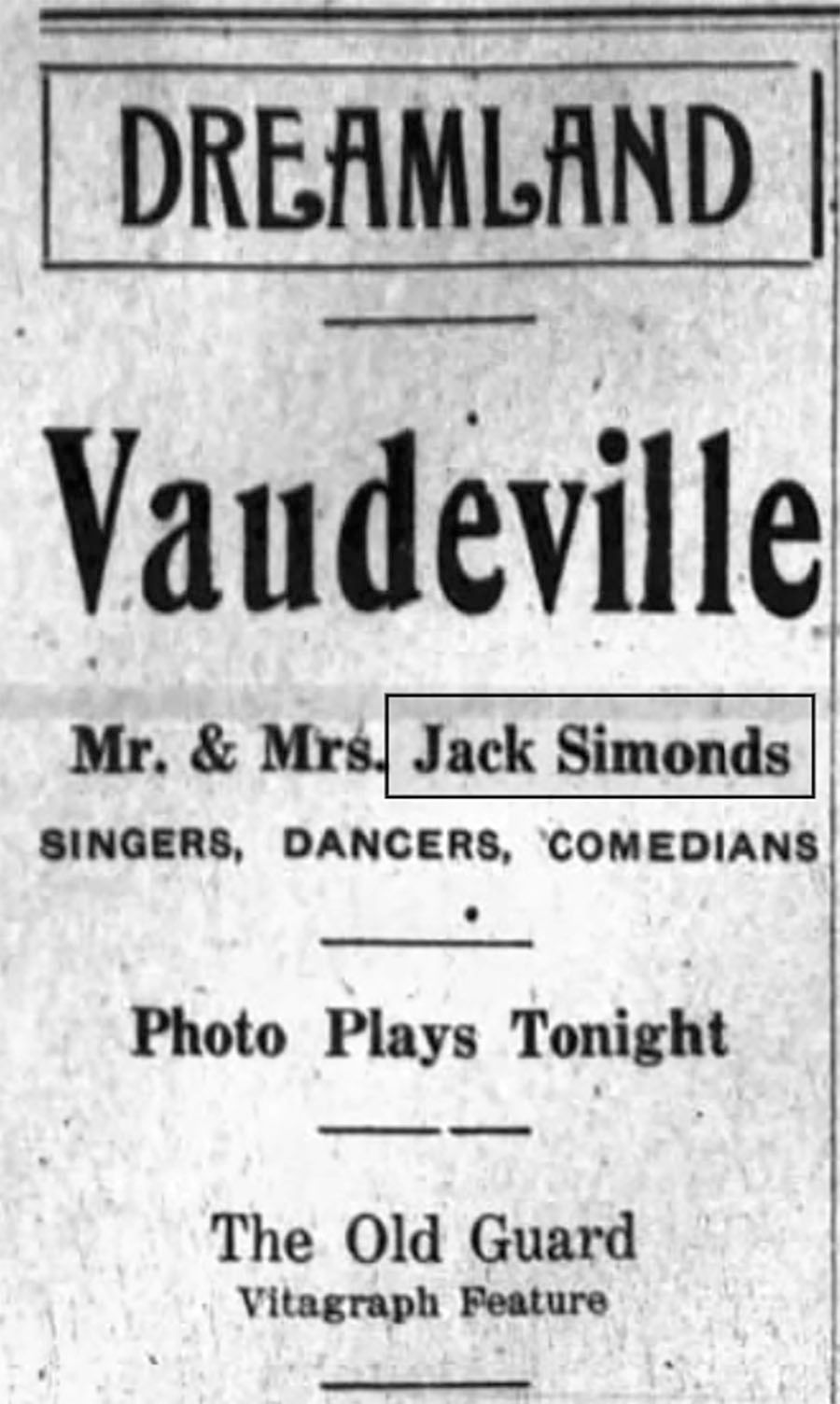Short-lived theater, Mark Twain Vaudet, featured early movies
- Mary Lou Montgomery

- Nov 12, 2024
- 7 min read
Updated: Nov 14, 2024

Jack Simonds, dressed for his role as ’Mulcahey,’ is pictured in the September 1898 edition of “The Phonoscope” entertainment magazine.
MARY LOU MONTGOMERY
The Mark Twain Vaudet, a movie house carved from the northern side of the lobby of the historic Windsor Hotel at the corner of Church and South Main streets, provided a unique opportunity for Hannibal-area residents in 1907 and 1908, to witness the newest in cinematic technology.
From its inception in December 1907, until the end of January 1908, the Vaudet was owned by a vaudeville-era actor, singer and comedian whose stage name was Jack Simonds.
Born John William Simons Jr., in 1866, Jack was the son of Rachel Kirtiman and John W. Simons of Orange County, New York. Siblings included William B. Simons, Sarah K. Simons, James S. Simons, Kale R. Simons, Jared L. Simons and Orrin W. Simons.
Simonds was the recipient of a press plug in the September 1898 edition of “The Phonoscope.”:
“This gentleman is a new comer in the phonograph world and is making as his picture shows, some very funny stories under the title of ‘Mulcahey.’ He writes all his stories and is rapidly coming to the front in his line. He does not confine himself to Irish stories. Mr. Simonds, like most of the phonograph artists, is a graduate from the stage. He has been with all kinds of companies; operatic, dramatic and vaudeville. His last engagement was with W.S. Hart, playing in the ‘Bells,’ the ‘Lady of Lyons,’ ‘Man in the Iron Mask,’ etc., where he acquired the liking for ‘Shakespearean’ readings. He has studied in this line and is now a splendid reader. He also reads from Whitcomb Riley’s Poems. Mr. Simonds is making records exclusively for the Lyric Phonograph Company.”
On Oct. 24, 1905, he was billed in The Poughkeepsie, N.Y., Eagle-News as “an entertaining monologuist, featuring a recitation of ‘Jim Bludsoe,’ written by the late John Hay, of Pike County, Ill. Mr. Simond’s great talent is character work.”
Columbia Four
Jack Simonds first came to Hannibal while a member of the Columbia (Comedy) Four, a quartet that performed in Hannibal on April 17, 1907.
The Courier-Post of April 18, 1907, reported: “The quartette is composed of the following members: Jack Simonds (tenor), Charles Witrock, Robert Gibner, and Thad Packard. They came back to this city to spend a week in visiting the best fishing points about the Mississippi. They will play a return engagement at the Star next week.”
Thad Packard’s quartet, including Jack Simonds, continued performing together for at least four years. They we’re featured at Young’s Ocean Pier Theater in Atlantic City, N.J. on September 10, 1911.
Vaudet
The furnishings and equipment for the Mark Twain Vaudet consisted of 144 common kitchen chairs; the projector was an Edison Exhibition Picture Machine No. 4532; Sound was provided via a Columbia Twentieth Century Phonograph and horn; and the cooling system for the theater consisted of three electric fans.
Tickets for the film showings were 5 cents each.
Simonds signed a contract with Bert Corbin, hotel owner, on Dec. 14, 1907. Simonds was to pay Corbin $10 per week for rent, beginning on Dec. 24, 1907. He made payments on Dec. 24 and 31, and Jan. 8, 13 and 20, at which time the payments stopped.
On Feb. 24, 1908, at Hannibal, John W. (Jack) Simonds, who was then 36 years old, volunteered and enlisted to serve as a soldier in the National Guard of the state of Missouri, in E Company, Fourth Regiment, for three years. J. Fred Meyer Jr., was captain of the 4th Infantry Command Company E. Meyer was filling a quota of 55 men to prepare for readiness should the need arise.
Company E subsequently formed an entertainment division, which hosted a ball in March 1908. Service members performing included Jack Simonds, who offered a comic song, Corporal Harry E. McClellan, and musician, James C. Ridge, an engineer for the CB&Q Railroad. The soldiers were all wearing their uniforms, which had just arrived two weeks prior. An estimated 100 couples attended the ball.
In the meantime, the Mark Twain Vaudet remained closed, its possessions confiscated by the landlord, until mid June 1908, when John B. Herl Jr., who operated a saloon across the street at 200-202 S. Main, filed a Petition in Replevin to obtain the property and reopen the Mark Twain Vaudet. Herl was represented by Hannibal attorney, Charles E. Rendlen.
Herl, in turn, sold the Mark Twain Vaudet equipment to Messrs. Harry E. McLellan and Levens. They contracted with Twentieth Century Obstacle company of Kansas City to furnish pictures and slides for the show.
The Hannibal Morning Journal of June 24, 1908, announced:
“There will be a change of program three times a week, and the program for each day will be printed in the Morning Journal. The new proprietors are energetic young men and if strict attention to business and courteous treatment to patrons will count for anything, they will make a success of their new enterprise.”
Traveling actor
Simonds' career, both before and after his temporary residence in Hannibal, took him from coast to coast and beyond.
In August 1900, Jack Simonds performed at the Opera House, Saint John, New Brunswick, Canada, with J. Harve Briggs, Fred Schmitt and Hank Goodman.
In March 1901, he performed, billed as “An Original Conversationalist,” at the Olympia, corner Eddy and Mason Streets, in San Francisco.
The July 4, 1902 edition of the Daily Morning Union and Herald, Grass Valley and Nevada City, California, wrote of Simonds’ performance there: “Old Jack Simonds, a man who has probably caused more people to laugh than any person at present on the stage, was there with his usual ‘hot air.’ He is, perhaps, one of the best monologuists in the country today.”
The press caught up with Simonds again on Oct. 10, 1905. The Passaic (New Jersey) Daily News reported: “Jack Simonds came … with a budget of comic patter, interesting songs and monologue, which was highly appreciated.”
Jack Simonds, previously divorced, headed to Ohio when he left Missouri, performing with the Fay Foster Company. It was there that he met Mayme Pratt (birth name Mary Louise Pratt) about 20 years his junior, an ensemble dancer performing at Cleveland’s Star Theater.
Featured in this stage performance were Grace Orma, a statuesque comedienne; the Columbia Four, including Jack Simonds; the Great Cavana; a gymnast; and May Orletta and Fred Taylor, dubbed as high class vocalists.
The engaged couple, convinced by their fellow actors, agreed to exchange wedding vows on the Star Theater stage, following the Nov. 12, 1908, live performance.
Jack and Mayme were excused from the final act, so that they could wash away the stage makeup and change into wedding attire. With the audience and all their cast members watching, they exchanged vows right there on stage. In attendance was Mary E. Schumacher Platt, a nervous and apprehensive mother of the bride from Muskingum County, Ohio.
Mrs. Pratt was dressed in plain black clothing, according to the Cleveland Plain Dealer, feeling “out of place in the bewildering crowd of young women in rouge and powder, with purple pigment under their eyelids, and stage gowns which reached only from their knees to within hailing distance of their shoulders.”
Mayme and Jack Simonds performed together as a couple, particularly around 1913.
Later, Jack performed with a new company. “The Gambols of 1921 have made a tremendous hit. This superfine company more than lived up to its advance notices and is easily the best that have ever played here. Their entertainment possesses novelty, class, and is absolutely refined with not a succession of any kind. The comics, Harry Moore and Jack Simonds, have the art of making the audience laugh at their finger tips and they made a big hit with everybody. Their comedy is very clean and they are a very funny pair and would make the proverbial cat laugh. Jack Gerrard, the leading man, also came in for lots of applause, as did Miss Edith Bates.”
The last newspaper article found by this author on Jack Simonds and his acting career was on March 13, 1922, when he performed at the Crystal Theater in Anderson, Ind.
Mayme Simonds died in 1917, and Jack Simonds died in 1936, according to family Ancestry records. Mr. Simonds had one daughter from his previous marriage, Helen Mora Simonds, born in Philadelphia. She was married to Horace Z. Loudon in 1915, and they later divorced.

This undated photo of the Windsor Hotel, from Steve Chou's collection, shows the front of the hotel, which was located on the northwest corner of Church Street and South Main. Note that the front of the building has two entrances. It was the entrance on the right side where the Mark Twain Vaudet was located during part of 1907 and 1908.

Jack Simonds was co-owner of the Mark Twain Vaudet when this advertisement was published in the Ralls County Record on Jan. 24, 1908. newspapers.com

“James Boys in Missouri,” an 18-minute film, was scheduled for showing at the Mark Twain Vaudet Aug. 7 and 8, 1908. Hannibal Courier-Post, Aug. 8, 1908. newspapers.com

This advertisement from August 1898 features a mention of Jack Simonds, and his Mulcahey Series, making talking records. newspapers.com

Advertisement from the Aug. 3, 1913 edition of the Marysville Journal-Tribune, Marysville, Ohio. Featured entertainers are Mr. and Mrs. Jack Simonds. newspapers.com
Mary Lou Montgomery retired as editor of the Hannibal (Mo.) Courier-Post in 2014. She researches and writes narrative-style stories about the people who served as building blocks for this region’s foundation. Books available on Amazon.com by this author include but are not limited to: "The Notorious Madam Shaw," "Pioneers in Medicine from Northeast Missouri,” “Hannibal’s ‘West End,’” “Oakwood: West of Hannibal,” and “St. Mary’s Avenue District.” Montgomery can be reached at Montgomery.editor@yahoo.com Her collective works can be found at www.maryloumontgomery.com
Below: This is a copy of a legal document found in files kept by Charles E. Rendlen (1890-1950). It offers details on the equipment owned by the Mark Twain Vaudet, which was confiscated by the landlord for non payment of rent. Rendlen represented John B. Herl Jr., in this petition to take possession of the property so that the theater could reopen. A box of documents were recovered from the basement of Poole Advertising, 108 N. Third, Hannibal. The Rendlen Law Firm was previously located in this location.



























コメント